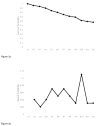Integrated, exposure-based treatment for PTSD and comorbid substance use disorders: Predictors of treatment dropout
- PMID: 28460246
- PMCID: PMC5507590
- DOI: 10.1016/j.addbeh.2017.04.005
Integrated, exposure-based treatment for PTSD and comorbid substance use disorders: Predictors of treatment dropout
Abstract
High rates of comorbid posttraumatic stress disorder (PTSD) and substance use disorders (SUD) have been noted in veteran populations. Fortunately, there are a number of evidence-based psychotherapies designed to address comorbid PTSD and SUD. However, treatments targeting PTSD and SUD simultaneously often report high dropout rates. To date, only one study has examined predictors of dropout from PTSD/SUD treatment. To address this gap in the literature, this study aimed to 1) examine when in the course of treatment dropout occurred, and 2) identify predictors of dropout from a concurrent treatment for PTSD and SUD. Participants were 51 male and female veterans diagnosed with current PTSD and SUD. All participants completed at least one session of a cognitive-behavioral treatment (COPE) designed to simultaneously address PTSD and SUD symptoms. Of the 51 participants, 22 (43.1%) dropped out of treatment prior to completing the full 12 session COPE protocol. Results indicated that the majority of dropout (55%) occurred after session 6, with the largest amount of dropout occurring between sessions 9 and 10. Results also indicated a marginally significant relationship between greater baseline PTSD symptom severity and premature dropout. These findings highlight inconsistencies related to timing and predictors of dropout, as well as the dearth of information noted about treatment dropout within PTSD and SUD literature. Suggestions for procedural changes, such as implementing continual symptom assessments during treatment and increasing dialog between provider and patient about dropout were made with the hopes of increasing consistency of findings and eventually reducing treatment dropout.
Keywords: COPE; Dropout; PTSD; Prolonged exposure; Substance use; Veteran.
Published by Elsevier Ltd.
Conflict of interest statement
There are no conflicts of interest to disclose.
Figures

Similar articles
-
Concurrent treatment of substance use disorders and PTSD using prolonged exposure: A randomized clinical trial in military veterans.Addict Behav. 2019 Mar;90:369-377. doi: 10.1016/j.addbeh.2018.11.032. Epub 2018 Nov 27. Addict Behav. 2019. PMID: 30529244 Free PMC article. Clinical Trial.
-
Substance use disorders and PTSD: Examining substance use, PTSD symptoms, and dropout following imaginal exposure.Addict Behav. 2019 Mar;90:35-39. doi: 10.1016/j.addbeh.2018.10.020. Epub 2018 Oct 16. Addict Behav. 2019. PMID: 30355535 Free PMC article. Clinical Trial.
-
Heterogeneity of treatment dropout: PTSD, depression, and alcohol use disorder reductions in PTSD and AUD/SUD treatment noncompleters.Clin Psychol Psychother. 2019 Mar;26(2):218-226. doi: 10.1002/cpp.2344. Epub 2018 Dec 13. Clin Psychol Psychother. 2019. PMID: 30419153 Clinical Trial.
-
No Wrong Doors: Findings from a Critical Review of Behavioral Randomized Clinical Trials for Individuals with Co-Occurring Alcohol/Drug Problems and Posttraumatic Stress Disorder.Alcohol Clin Exp Res. 2017 Apr;41(4):681-702. doi: 10.1111/acer.13325. Epub 2017 Feb 10. Alcohol Clin Exp Res. 2017. PMID: 28055143 Review.
-
Treating child abuse-related posttraumatic stress and comorbid substance abuse in adolescents.Child Abuse Negl. 2003 Dec;27(12):1345-65. doi: 10.1016/j.chiabu.2003.08.001. Child Abuse Negl. 2003. PMID: 14644054 Review.
Cited by
-
Concurrent treatment of substance use disorders and PTSD using prolonged exposure: A randomized clinical trial in military veterans.Addict Behav. 2019 Mar;90:369-377. doi: 10.1016/j.addbeh.2018.11.032. Epub 2018 Nov 27. Addict Behav. 2019. PMID: 30529244 Free PMC article. Clinical Trial.
-
Expanded Roles and Recommendations for Stakeholders to Successfully Reintegrate Modern Warriors and Mitigate Suicide Risk.Front Psychol. 2020 Aug 21;11:1907. doi: 10.3389/fpsyg.2020.01907. eCollection 2020. Front Psychol. 2020. PMID: 32973608 Free PMC article.
-
Substance use disorders and PTSD: Examining substance use, PTSD symptoms, and dropout following imaginal exposure.Addict Behav. 2019 Mar;90:35-39. doi: 10.1016/j.addbeh.2018.10.020. Epub 2018 Oct 16. Addict Behav. 2019. PMID: 30355535 Free PMC article. Clinical Trial.
-
Impulsivity, trauma history, and interoceptive awareness contribute to completion of a criminal diversion substance use treatment program for women.Front Psychol. 2024 Sep 4;15:1390199. doi: 10.3389/fpsyg.2024.1390199. eCollection 2024. Front Psychol. 2024. PMID: 39295754 Free PMC article.
-
A compassion microintervention targeting stress reactivity among sexual minority women and transgender/nonbinary people: Study protocol for a randomized controlled trial.Contemp Clin Trials. 2024 Oct;145:107660. doi: 10.1016/j.cct.2024.107660. Epub 2024 Aug 8. Contemp Clin Trials. 2024. PMID: 39121992 Free PMC article.
References
-
- American Psychiatric Association. Diagnostic and statistical manual of mental disorders. 4. Washington DC: American Psychiatric Association; 2000. text revision.
-
- American Psychiatric Association. Diagnostic and statistical manual of mental disorders. 5. Washington, DC: American Psychiatric Association; 2013.
-
- Back SE, Foa EB, Killeen TK, Mills KL, Teesson M, Dansky Cotton B, … Brady KT. Concurrent treatment of PTSD and substance use disorders using prolonged exposure (COPE): Therapist guide. New York, NY: Oxford Press; 2014.
Publication types
MeSH terms
Grants and funding
LinkOut - more resources
Full Text Sources
Other Literature Sources
Medical
Miscellaneous

